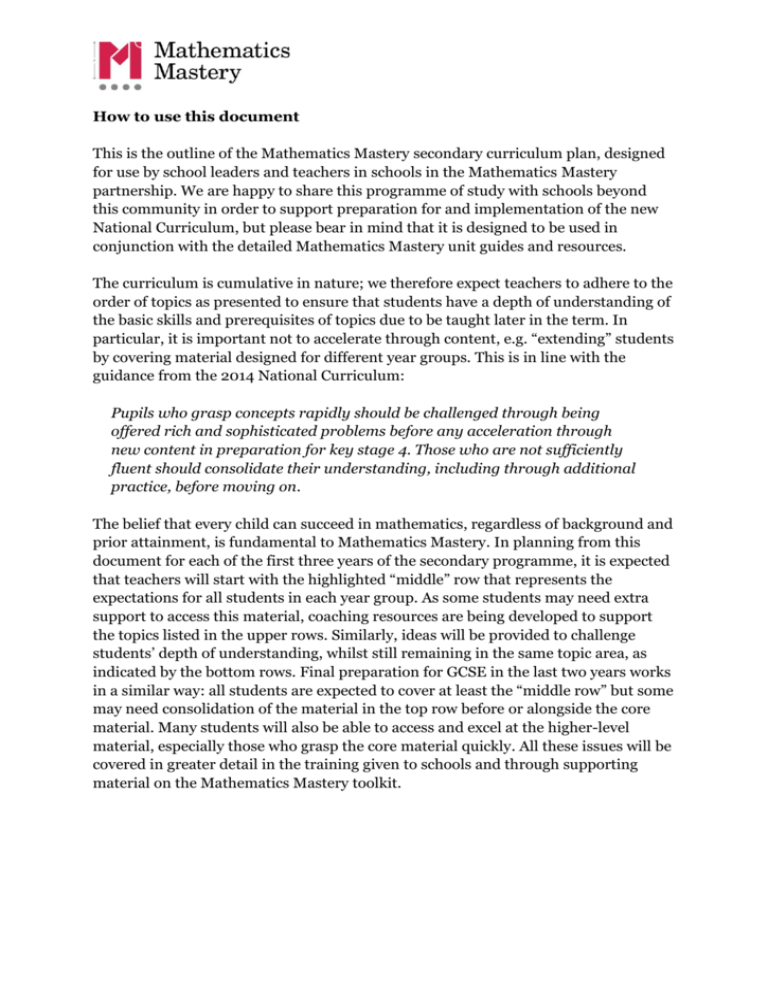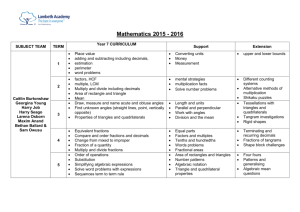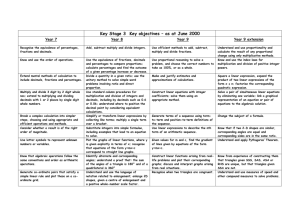How to use this document This is the outline of the Mathematics
advertisement

How to use this document This is the outline of the Mathematics Mastery secondary curriculum plan, designed for use by school leaders and teachers in schools in the Mathematics Mastery partnership. We are happy to share this programme of study with schools beyond this community in order to support preparation for and implementation of the new National Curriculum, but please bear in mind that it is designed to be used in conjunction with the detailed Mathematics Mastery unit guides and resources. The curriculum is cumulative in nature; we therefore expect teachers to adhere to the order of topics as presented to ensure that students have a depth of understanding of the basic skills and prerequisites of topics due to be taught later in the term. In particular, it is important not to accelerate through content, e.g. “extending” students by covering material designed for different year groups. This is in line with the guidance from the 2014 National Curriculum: Pupils who grasp concepts rapidly should be challenged through being offered rich and sophisticated problems before any acceleration through new content in preparation for key stage 4. Those who are not sufficiently fluent should consolidate their understanding, including through additional practice, before moving on. The belief that every child can succeed in mathematics, regardless of background and prior attainment, is fundamental to Mathematics Mastery. In planning from this document for each of the first three years of the secondary programme, it is expected that teachers will start with the highlighted “middle” row that represents the expectations for all students in each year group. As some students may need extra support to access this material, coaching resources are being developed to support the topics listed in the upper rows. Similarly, ideas will be provided to challenge students’ depth of understanding, whilst still remaining in the same topic area, as indicated by the bottom rows. Final preparation for GCSE in the last two years works in a similar way: all students are expected to cover at least the “middle row” but some may need consolidation of the material in the top row before or alongside the core material. Many students will also be able to access and excel at the higher-level material, especially those who grasp the core material quickly. All these issues will be covered in greater detail in the training given to schools and through supporting material on the Mathematics Mastery toolkit. Year 7 Autumn 2 Autumn 1 Summer 1 Explain and Spring 1 Spring 2 Solve word problems Applications of investigate (multiply Geometry Fractions (add and subtract) algebra and divide) All should be confident and competent in Key Stage 2 material. Review of these prerequisites may be useful for each unit: Number bonds Mental strategies Lengths and units Equal parts Areas of rectangles Convert units Multiplication facts Parallel and and triangles Factors and multiples perpendicular Money +/− Multiplication Number patterns Tenths and strategies Measurement Work with angles hundredths Algebraic notation Solve number Division and the Word problems Triangle and problems mean quadrilateral Fractional areas properties All will have access to this specific Key Stage 3 content: Place value (including Factors, HCF, Draw, measure and Equivalent fractions Order of operations decimals) multiples, LCM name acute and Compare and order Substitution obtuse angles Add and subtract Multiply and divide fractions and Simplify algebraic (including decimals) (including decimals) decimals Find unknown angles expressions (straight lines, at a Estimation Area of rectangle and Change mixed Solve word problems point, vertically triangle numbers to improper with expressions Perimeter opposite) fractions and vice Calculate the mean Word problems Sequences (term-toversa Properties of term, not nth term) triangles and Fraction of a quantity quadrilaterals Multiply and divide fractions Summer 2 Percentages and statistics Decimals and problem solving Fractions of shapes Equivalence Order of operations Construct and interpret statistical diagrams including pie charts Convert between percentages, vulgar fractions and decimals Percentage of a quantity Find the whole, given the part and the percentage As well as looking at the termly projects, highest attaining students may be stretched through depth by consideration of the following: Different counting Shikaku puzzles Comparing and Tessellating triangles Terminating and Four fours systems or bases converting between Different counting and quadrilaterals recurring decimals Patterns and systems or bases representations Generalisation generalising Tangram Fractions of tangrams Applications of Upper and lower Alternative methods investigations Shape block Algebraic mean bounds of multiplication percentages Rigid shapes challenges questions Generalisation This framework follows the content and assessment objectives set out by DfE and Ofqual and, hence, reflects the requirements of GCSE mathematics offered by AQA, Eduqas, OCR and Pearson. Year 8 Spring 2 Summer 1 Summer 2 Proportional 3-D geometry Statistics reasoning All should be confident and competent with Year 7 material. Review of these prerequisites may be useful for each unit: Factors, multiples Problem solving with Angle types Rounding Rectilinear areas Statistical diagrams and primes fractions Angle facts Bar modelling with Fraction +/− Ratio and rate Multiplication and Order of operations Rectangle and factions Problem solving with The mean division triangle areas Form algebraic fractions Fraction ×/÷ Calculator skills and expressions Fraction equivalence ×/÷ by powers of 10 Percentage increase Bar modelling with rounding and calculations Substitution Problem solving with and decrease equations negative numbers Substitution with FDP equivalence negatives All will have access to this specific Key Stage 3 content: Primes and indices Negative numbers Draw accurate Convert between Rounding, significant Collect and organise and inequality triangles and percentages, vulgar figures and data Prime factorisation to statements quadrilaterals (ruler, fractions and estimation find LCM, HCF, Interpret and protractor, decimals squares, cubes compare statistical Formulate and Circumference and compasses) evaluate expressions area of a circle representations Percentage increase Venn diagrams Find unknown angles and decrease, finding Visualise and identify Mean, median and Linear equations Enumerating sets (including parallel the whole given the 3-D shapes and their mode averages Expressions and Add and subtract lines) part and the nets equations from real The range and fractions percentage Conversion between world situations Volume of cuboid, outliers length units and Ratio (equivalent, of prism, cylinder, Linear sequences: nth between area units a quantity) and rate composite solids term Areas and perimeters Speed, distance, time of composite figures Areas of parallelograms and trapeziums As well as looking at the termly projects, highest attaining students may be stretched through depth by consideration of the following: Egyptian fractions Platonic solids Misleading graphs Explore non-linear Similarity and ratio Density Continued fractions Percentage errors Equal width sequences Complex Area scale factors histograms HCF and LCM Plans and elevations T-totals constructions Loan repayment generalisation Sampling methods Simple angle proofs Autumn 1 Number Autumn 2 Algebraic expressions Spring 1 2-D geometry This framework follows the content and assessment objectives set out by DfE and Ofqual and, hence, reflects the requirements of GCSE mathematics offered by AQA, Eduqas, OCR and Pearson. Year 9 Autumn 1 Spring 2 Autumn 2 Spring 1 Summer 1 Summer 2 Graphs and Equations and Algebraic expressions 2-D geometry Geometry Statistics proportion inequalities All should be confident and competent with Year 7 and 8 materials. Review of these prerequisites may be useful for each unit: Read scales Make expressions Area and Linear graphs Compound areas Venn diagrams and circumference Linear equations Expressions and area two-way tables Sequences FDP conversion Proportion Substitution Angles on lines and in Manipulate formulae Powers of 10 and Averages and the triangles Percentage increase Powers and roots standard form range Problem solving with and decrease Problem solving with Angles in parallel Number problems algebra a calculator lines with fractions and Pie charts decimals Problem solving with algebra All will have access to this specific Key Stage 3 content: Cartesian coordinates Sequences including Construction and loci Construct and solve Pythagoras’ theorem ProbabilityMean of arithmetic and equations and grouped data Linear graphs Triangles and Exploring geometric inequalities quadrilaterals (angles trigonometry with a Compare two data Direct and inverse on diagonals) 30-60-90 triangle sets Algebraic Graphical solutions to proportion manipulation simultaneous linear Congruence and Transformations Stem-and-leaf Calculate with scales equations Change the subject of similarity (translation, rotation, diagrams Standard form a formula reflection) Quadratic and other Angles in polygons Scatter graphs graphs Expansion Use known angle and shape facts to obtain Factorisation simple proofs As well as looking at the termly projects, highest attaining students may be stretched through depth by consideration of the following: 3-D coordinates Further trigonometry Probability problems Algebraic proof Geometrical proof Regions on graphs Explore linear and Multiple Equations of lines of Euclidean geometry Linear programming non-linear graphs transformations best fit Complex Modelling 3-D Pythagoras constructions Throughout Year 9 Approximation and significant figures Addition, subtraction, multiplication and division with whole numbers, fractions and decimals Percentage increase and decrease, finding the whole given the part and the percentage This framework follows the content and assessment objectives set out by DfE and Ofqual and, hence, reflects the requirements of GCSE mathematics offered by AQA, Eduqas, OCR and Pearson. Year 10 Summer 1 Summer 2 Sampling & Applications of probability algebra All should be confident and competent in Key Stage 3 material. Review of these prerequisites may be useful for each unit: Calculate with Ratio notation, links Algebraic notation Decimal calculations Sample spaces Real-life graphs fractions to vulgar fractions, and substitution, and rounding The probability scale Deriving and using decimals and including kinematics expressions, formulae Convert and solve Units Vulgar fractions, problems with percentages formulae decimals and and equations Area and perimeter of fractions and plane shapes, percentages Reflection, rotation Congruence percentages and translation including composite Straight-line graphs shapes Review indices Pythagoras’ theorem Equations and inequalities Angle rules Rearranging formulae All will be assessed on this specific Key Stage 4 content Populations and Calculations with and Enlargement Algebraic arguments Properties of 3-D Expand and factorise samples rules of indices shapes; their plans binomials Similar shapes Loci Theoretical and and elevations Bearings Calculations with Quadratic equations Key angle and shape experimental standard form Trigonometry in right Estimation facts Cubic and reciprocal probability angled triangles Surface area and Compound interest graphs Coordinates Listing volume of pyramids, Growth and decay (including midpoints, Simultaneous Set notation cones and spheres Standard non-linear problems) equations Venn diagrams (including exact sequences Equations of parallel Graphical solutions of Combined events, answers) & perpendicular lines equations including tree Angle proofs Vectors diagrams Limits of accuracy Highest attaining students will also be assessed on the following material, which provides good preparation for Key Stage 5 Recurrence relations Negative scale factors Vector proofs Similar areas and Conditional Exponential graphs of enlargement volumes probability Surds Trigonometry graphs Complete the square; quadratic formula Recurring decimals 3-D trigonometry and Equations of Upper and lower Pythagoras’ theorem perpendicular lines bounds Fractional indices Quadratic inequalities Quadratic sequences Further inequalities Trigonometry in all Combine triangles transformations Algebraic fractions Throughout KS4: Students will need to keep working on key skills as they occur within other topics, as well as when the skills are being explicitly addressed. These include: Addition, subtraction, multiplication and division; order of operations; fractions, decimals and percentages; rounding and estimation; and algebraic notation. Autumn 1 Number Autumn 2 Geometry Spring 1 Reasoning Spring 2 Geometry & number This framework follows the content and assessment objectives set out by DfE and Ofqual and, hence, reflects the requirements of GCSE mathematics offered by AQA, Eduqas, OCR and Pearson. Year 11 Autumn 1 Autumn 2 Spring 1 Spring 2 Summer 1 Summer 2 Algebra and geometry Number & statistics Revision, extension 1 Revision, extension 2 Revision, extension 3 Examinations All should be confident and competent in Key Stage 3 material. Review of these prerequisites may be useful for each unit: Ratio calculations Simple statistical Review and revision Review and revision Review and revision Review and revision Direct and inverse diagrams proportion Averages and the Derive and use range expressions, formulae Solve number and equations problems All will be assessed on this specific Key Stage 4 content Arcs and sectors of Represent and Review and revision Review and revision Review and revision Review and revision circles describe distributions Using angle and Identify misleading shape facts to derive graphs results Time series Proof in algebra and Correlation and lines geometry of best fit Variation Solve problems involving compound units Highest attaining students will also be assessed on the following material, which provides good preparation for Key Stage 5 Apply and prove Histograms with Functions and their Solve equations by Review and revision Review and revision circle theorems equal and unequal inverses iteration class intervals Equation of a circle Composite functions Gradients of curves and the tangent to a and areas under Cumulative frequency Transformations of circle functions graphs graphs and box plots Variation with powers Throughout KS4: Students will need to keep working on key skills as they occur within other topics, as well as when the skills are being explicitly addressed. These include: Addition, subtraction, multiplication and division; order of operations; fractions, decimals and percentages; rounding and estimation; and algebraic notation. This framework follows the content and assessment objectives set out by DfE and Ofqual and, hence, reflects the requirements of GCSE mathematics offered by AQA, Eduqas, OCR and Pearson.







